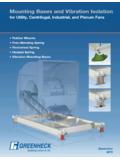Transcription of Fisher 1052 Size 20 Diaphragm Rotary Actuator …
1 1052 size 20 Diaphragm Rotary Actuatorwith H mounting of Compression Spring of Actuator Mounted 1. Fisher 1052 size 20 Actuator with H mounting AdaptationW4140-1 IntroductionScope of ManualThis instruction manual includes installation, adjustment, operation, maintenance, and parts ordering information forthe Fisher 1052 size 20 Diaphragm Rotary Actuator with H mounting (figure 1) and the optional top mountedhandwheel (see figure 7). Instructions for the Rotary positioner and other accessories are included in separateinstruction not install, operate, or maintain a 1052 Actuator without being fully trained and qualified in valve, Actuator , andaccessory installation, operation, and maintenance. To avoid personal injury or property damage, it is important tocarefully read, understand, and follow all the contents of this manual, including all safety cautions and warnings. If youhave any questions about these instructions, contact your Emerson sales office or Local Business Partner ManualD100323X0121052 size 20 Actuator (H)June 2017 Instruction ManualD100323X0121052 size 20 Actuator (H)June 20172 Table 1.
2 SpecificationsOperating PrincipleDirect Increasing loading pressure forces thediaphragm rod from the top to the bottom of thecasingCasing Pressure Ranges J 0 to bar (10 to 18 psig), J 0 to bar (0 to33 psig), or J 0 to bar (0 to 40 psig) dependingon spring used for proportional control; up to bar(50 psig) for on off controlMaximum Allowable Sizing Pressure(1) bar (50 psig)Maximum Rotation90 degrees (travel is adjustable between 60 degreesand 90 degrees by travel stops)Maximum Allowable Output Torque58 NSm (515 lbfSin)Stroking TimeDepends on degrees of rotation, spring rate, initialspring compression, and supply pressure. If strokingtime is critical, consult your Emerson sales office orLocal Business Temperature Capabilities(1)-40 to 180_F (-40 to 82_C)Pressure Connections1/4 NPT internalMounting ConfigurationsSee figure 5 Approximate kg (30 lb)Top Mounted Handwheel SpecificationsOperating Principle: Can be used for manualoperation of the Actuator or as an adjustable up travelstopDiameter: 171 mm ( inches)1.
3 Use this value to determine the maximum torque output. The pressure temperature limits in this manual and any applicable code or standard should not be 1052 size 20 spring and Diaphragm Actuator is used on small Rotary shaft valves and other equipment forthrottling or on off control applications. This Actuator accepts a 3610J, 3620J, or PMV positioner, and a top mountedhandwheel is available for the Style H mounting adaptation permits the Actuator to be used with user provided mounting brackets andcouplings for Rotary actuation of equipment other than Fisher valves. This mounting adaptation includes a flat surfaceactuator mounting plate that is drilled and tapped for attaching the user provided bracket. Cap screws for attachingthe bracket are provided. The H mounting also includes an output shaft ( with two milled flats) to provide the rotaryoutput, either directly or through a user provided information for the mounting plate and output shaft are shown in figure are shown in table 1 for 1052, size 20, Style H actuators.
4 Some specifications for a given Actuator as itoriginally comes from the factory are stamped on a nameplate attached to the ManualD100323X0121052 size 20 Actuator (H)June 20173 Installation WARNINGA lways wear protective gloves, clothing, and eyewear when performing any maintenance operations to avoid injury or equipment damage caused by sudden release of pressure might result if the valve assembly is installedwhere service conditions could exceed the limits given in table 1 or on the appropriate nameplates. To avoid such injury ordamage, provide a relief valve for overpressure protection as required by government or accepted industry codes and goodengineering with your process or safety engineer for any additional measures that must be taken to protect against installing into an existing application, also refer to the WARNING at the beginning of the Maintenance section in thisinstruction avoid parts damage, do not use an operating pressure that exceeds the Maximum Diaphragm Casing Pressure (table 1)or produces a torque greater than the Maximum Allowable Valve Shaft Torque (see Catalog 14).
5 Use pressure limiting orpressure relieving devices to prevent the Diaphragm casing pressure from exceeding its 1/4 NPT pressure connection is located on top of the Actuator . Run either NPS 1/4 pipe or 3/8 inch tubing betweenthe pressure connection and the instrument. Keep the length of tubing or pipe as short as possible to avoidtransmission lag in the control signal. If a positioner is used, the pressure connection to the Actuator is normally madeat the the Actuator is completely installed and connected to the instrument, check it for correct action (air to open orair to close) to match the controlling instrument. For successful operation, the Actuator rod and equipment operatingshaft must move freely in response to the loading pressure change on the Compression AdjustmentSpring adjustment is shown in figure 2. Key numbers are shown in figure Spring CompressionThe 1052 nameplate specifies a SPRING INITIAL SET, which is the initial compression adjusted into the Actuator compression is the casing pressure at which the Diaphragm (key 3) and Diaphragm rod (key 10) begin to moveaway from the up travel stop.
6 The initial compression is selected (based upon the service conditions specified whenthe Actuator was ordered) so that when the Actuator is in service on the operated equipment, the equipment closesproperly and full travel is obtained within a specified casing the Actuator has been disassembled, or if the spring adjustment was changed, do NOT adjust the initial compressionto exceed the SPRING INITIAL SET value on the ManualD100323X0121052 size 20 Actuator (H)June 20174 Figure 2. Spring AdjustmentW6761 1 NOTCHED PORTION OFSPRING ADJUSTERDOWNTRAVEL STOPTRAVELINDICATORUPTRAVEL STOPCLAMPEDLEVERP roper bench set of the spring can only be made when the Actuator up travel stop has been approximately a shaft in the Actuator and adjust the up travel stop before establishing spring compression (since there is notravel stop in the upper Diaphragm casing). Considerable error in adjustment is certain if the above procedure is notfollowed.
7 This error can result in under travel of the Actuator when the spring goes solid or excess compression hasbeen the spring so that the Diaphragm rod just starts to travel at the SPRING INITIAL SET pressure specified on thenameplate. To adjust the spring, remove the positioner, if one is used, or the cover. The lower part of the springadjuster is notched, as shown in figure 2. Using a screwdriver as shown in figure 2, rotate the notches to the right todecrease spring compression or to the left to increase spring compression. Replace the positioner or the cover whenadjustment is RangeThe SPRING INITIAL SET listed on the nameplate is the optimum setting, and spring adjustments that cause this valueto change or be exceeded are not recommended. For push down to open action, the initial spring set is normally themaximum allowable to provide the maximum spring closing force. Any increase in this setting may overstress thespring at full travel.
8 For push down to close action, the initial spring set is the optimum balance between theair to close and spring to open breakout , under operating conditions, the stroking range does not match the intended casing pressure, it may be possible toshift the stroking range by adjusting the spring to change the initial spring compression. A spring adjustment shifts thecasing pressure span and equally increases (or decreases) the casing pressure at which the Actuator begins to strokeand the pressure at which the Actuator reaches full adjust the spring, remove the positioner, if one is used, or the cover. The lower part of the spring adjuster isnotched, as shown in figure 2. Using a screwdriver as shown in figure 2, rotate the notches to the right to shift thecasing pressure span downward, or to the left to shift the casing pressure span upward. Replace the positioner or ProcedureUse the following steps to connect the Actuator to valve body or other equipment.
9 Key numbers are shown in figure dimensions are shown in figure ManualD100323X0121052 size 20 Actuator (H)June 20175 Figure 3. Center of Gravity Dimensions14B8083-ANOTE:CENTER OF GRAVITY INCLUDES YOKE ( )125( )mm(INCH)NoteFind dimensions and center of gravity information in figures 3 and 4 and the approximate weight in table 1. This information isrequired for fabrication of the proper bracket and Attach an appropriate mounting bracket (not provided) to the mounting plate (key 22) in the desired orientationwith the cap screws (key 78). See figure 4 for mounting dimensions on the mounting plate. Tighten the cap screwsto the value in table Consult figure 5 for available mounting styles and positions. The Actuator is normally positioned vertically with thevalve or other equipment in a horizontal the milled flats on the end of the Actuator output shaft (key 87) are oriented so that the output shaft cannot accommodate theoperated equipment shaft, refer to the Changing Positions procedure of the Changing Actuator mounting section.
10 This proceduredescribes how the output shaft can be repositioned to accommodate the operated equipment Slide the Actuator ( with the user provided mounting bracket attached) into the user provided coupling on theoperated shaft. Then, secure the Actuator to the operated equipment in the desired mounting position withappropriate fasteners, such as mounting cap screws. See figure 4 for output shaft of OperationRefer to figure 6. The Diaphragm rod (key 10) moves down as loading pressure is increased on top of the Diaphragm (key 3). As the loading pressure is decreased, the spring (key 11) forces the Diaphragm rod ManualD100323X0121052 size 20 Actuator (H)June 20176 The spring and Diaphragm are selected to meet the requirements of the application and, in service, the actuatorshould produce full travel of the operated equipment with the Diaphragm pressure as indicated on the the positioner instruction manual for Actuator principle of operation with parts are subject to normal wear and must be inspected and replaced as necessary.

















